Australia Birds 2
This section showcases some of the birds of Australia found near water,
both fresh and salt.
On our Australian Birds 1 page we show
some of the more common land birds we found on our travels.
Photos large and small are copyright HackingFamily.com,
credits Sue Hacking, unless otherwise noted.
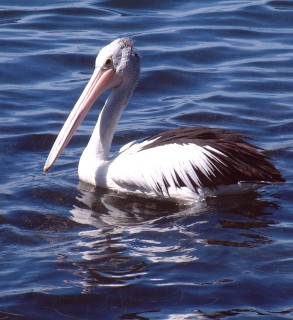 |
Soon after our arrival in Australia we tied up at the pilings on the Brisbane River we were
graced by a very large, surprisingly graceful Australian Pelican
(Pelecanus conspicillatus) which perched on the pilings or drifted
sedately among the boats. Colonies of breeding pelicans are found
throughout Australia in both fresh and salt water habitats. They fly in
V formation and often feed together in flocks. Australian Pelicans are black and white,
with a long pink bill, short legs and webbed feet. They are 1.6‑1.8m (5.5 feet)
from bill to tail, with a wingspan of about 2.4m (almost 8 feet). (Victoria coast) |
| Often seen near the pelicans is another common Australian water
bird: the Pied Cormorant (Phalacrocorus varius). Shyer than
the pelicans, they are difficult to approach for a photo, even in a
dinghy. They are found in salt, fresh and estuarine environments,
usually on large bodies of water. Cormorants feed on fish by diving from
the surface and swimming underwater. While underwater they use their
feet to propel them and have their eyes protected by a thin membrane.
After diving they often spread their wings to air and dry them. Eggs are
laid on tree platforms or the ground. Cormorants have long necks and
hooked bills. The Pied Cormorants have all-white necks and fly in
V formation. They make a grunting sound. The black leg stripe is a
characteristic shared by both the Black-faced and Pied Cormorants. (Sandy Straits, Queensland) |
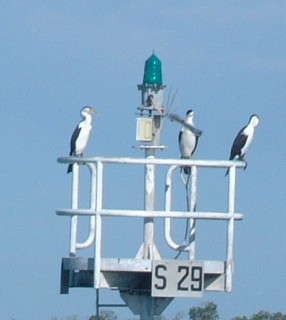 |
| Where to find water birds in
Australia. For a dry continent, Australia has plenty of water
-- thousands of kilometers of shore line, for a start. By the ocean look for
pelicans, cormorants, oystercatchers, rapidly running sandpipers and the
pelagic visitors like boobies and albatrosses. On rivers and lakes
you'll likely see the hovering kingfishers and the still herons.
Geese, moorhens and ducks abound on lakes and quiet waterways. And
lovely (but noisy and assertive) gulls can be found around seashore
campsites. Listed in the guide books you'll find bird parks that
feature some of the more unusual birds. The Australian birding will
astound you! |
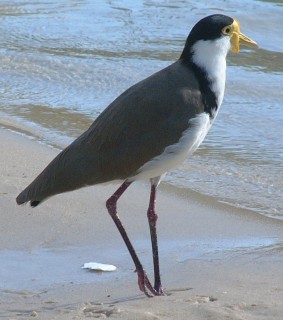 |
The Masked Lapwing (Vanellus miles) has two races in
Australia. Shown to the left is race novaehollandiae, also known
as the Spur-Winged Plover, which is distributed throughout
greater southeast Australia. It is distinguished from race miles
by location, the extent of the prominent yellow wattle - on miles
it extends behind the eye and hangs twice as long - and the black on the
hind-neck and sides of the breast. Hybrids are known to occur. The name
Spur-Winged Plover comes from the spur at the bend of wing (not visible).
Masked Lapwings grow to 14 inches (35 cm) and live in grasslands,
mud flats and urban parks. They're usually seen on the ground. This one
was at the man-made swimming pool "beach" in Southbank. (Brisbane, Queensland) |
| On mooring lines of the yachts in the Brisbane River, Australia we often had a
visitor from the nearby mangroves: the compact little Striated
(Mangrove) Heron Butorides (Ardeola) striatus. Shown
here in its non-threatened posture, the Striated Heron normally sits
low, with neck retracted when disturbed. Residing in intertidal flats
and mangroves, this small (49 cm or 19in) heron can be found along most of the
eastern and northern coasts of Australia. It has a glossy black crown
with a nuchal crest (barely visible here), and, in the Eastern
Australian race, very little striation on the neck plumage. The
juveniles display more white than the adults. (Brisbane River, January) |
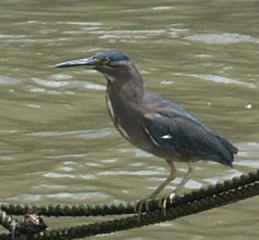 |
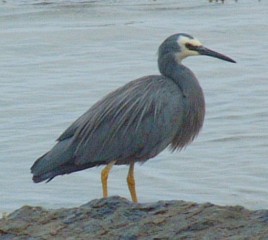 |
In addition to being found on intertidal flats, the White Faced
Heron (Egretta novaehollandiae) can also be seen on Australia's inland
pastures, dams and farmland. It is seen throughout all but the driest
interior of Australia. Standing 60‑70 cm (24‑27in) tall, it has uniformly gray
plumage except for white on the face and upper neck, to just behind the
eye. Hackles on the lower neck are prominent in this photo. (Great Ocean
Road, Victoria, January) |
| The Black Winged Stilt (Himantopus himantopus) is an all
white and black bird with a white breast, black wings and a black nape.
Its long slender legs are bright pink. Found in both fresh and saltwater
marshes, this bird has a strange call, a sort of yelp! The front toes of
stilts are partially webbed, but stilts do not swim. The Black Winged
Stilt is found world-wide, including Australia. (Photo taken of captive birds, Brisbane
Forest Park) |
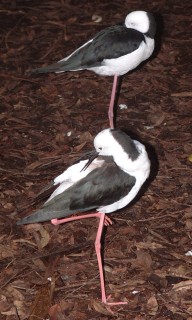 |
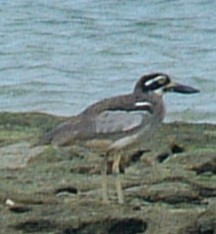 |
On the Low Isles, off Australia's North Queensland coast we put ashore in the
dinghy and had some good bird-watching. Two distinctively marked
Beach Stone Curlews (Esacus neglectus) with their very long,
stout beaks and white stripes on the head and shoulder were searching
the tide pools for food. Formerly known as Beach Thick Knees
(E. maginirostris), they are found on many of the coastal fringes of
tropical eastern and northern Australia, but never in large numbers.
Their call is a wailing, mournful "wee loo". (Low Isles, Queensland, in
June) |
| Classified as a bird of prey, not a "water bird", the Osprey
(Pandion haliaetus), however, fits appropriately on this page of
birds that reside on or near water. Ospreys are found near water, both
fresh and salt, around the world, and there is only one species. They
are specialized fish-catchers with nostrils that can close when plunging
feet first for fish from great heights; they have a reversible toe
used for clutching and carrying. Ospreys build nests of sticks in trees,
shrubs or on the ground, and use the same nest for years and years until
they become huge structures. This bird may be a young adult, because of
the very clear breast band which fades with maturity. It lived in a
relatively small nest on an offshore island along the Queensland coast. We saw ospreys frequently along the New South Wales and Queensland coasts. They
stand 55‑66 cm (22‑26 in) tall. (Morris Island) |
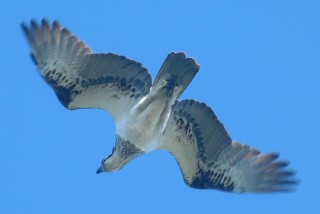 |
Unlike other continents with many seagull species, Australia has only 3 species
that are not vagrant: the Pacific Gull (63 cm or 25 in) and the Kelp Gull
(57 cm or 22 in) and the much smaller Silver Gull (4 cm or 16 in).
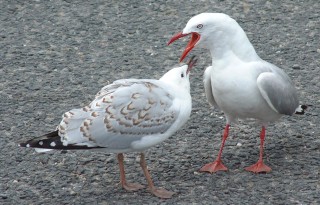
Raucous, aggressive, and omni-present on beaches and parklands of coastal and
inland waterways are the actually very lovely Silver Gulls,
(Larus novaehollandiae). Bright red bills and legs mark the Silver Gull
adults, while the juveniles have duller legs and bill and mottled brown
feathers. At Wilson's Promontory in New South Wales the gulls were
constant companions at the park "barbie" (BBQ) stands, ready to
snatch food from the grill to feed their mewing young. They
would also sit all over cars, and hop inside if they got the chance! The
photo shows a juvenile (left) with its parent. |
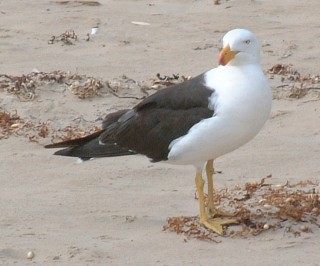
The less common Pacific Gull (Larus pacificus) is found only on
the shoreline of the south coast of Australia and parts of Tasmania. Large and
aggressive, it roosts on boats and pilings and scavenges in garbage dumps (sorry,
"tips" in Aus-speak). It matures in 4 years, progressing through various
pattern/color changes. The adults have yellow bills with dark red tips, black
back and wings and white head and chest. |
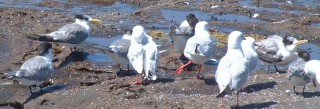 |
Silver gulls and Crested Terns (Sterna bergii) were
often seen together on the coasts. Right, the adult Crested Tern is center,
with a mottled juvenile behind. Distinguished by their dark black cap and shaggy crest, they are a large
tern with powerful flight. They range from the central Pacific west to
Africa. (Left: NSW, Right: Queensland) |
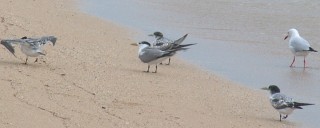 |
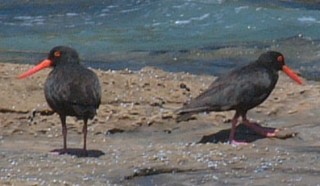 |
Oystercatchers can be found on any part of the Australian coast. The
Sooty Osytercatcher (Haematopus fuliginosus, left) is
endemic to Australia and relatively unusual to see. The Pied
Oystercatcher (Haematopus longirostris, right) is found
world-wide. Oystercatchers use their long, strong beaks to pry open
bivalve shells or break apart crustaceans for food. They stay with mates
for long periods, and are semi-nomadic. (Photo left: NSW coast. Right:
Queensland) |
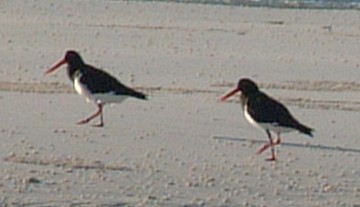 |
Ducks, geese and swans are everywhere in the world, it seems, and Australia is
no exception. One familiar one we saw was the green-headed, red-breasted
Mallard,
which was introduced into Australia. Many of the ducks we saw in Australia were,
unfortunately, in captivity at wetlands and habitat centers, but they were also
on rivers and streams as we toured the SE interior and sailed up the coast.
| Pacific Black Ducks (Anas superciliosa) are generally
dark, with a purple-green speculum and dark lines on an otherwise pale
head. They live in heavily vegetated swamps with deep, permanent pools
as well as more open lakes, paddocks and dams. We frequently saw them
along the Brisbane River, but this pair we photographed in Toowoomba,
Queensland. |
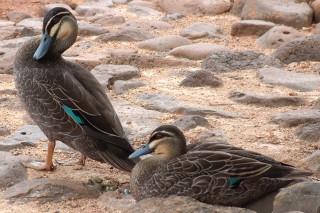 |
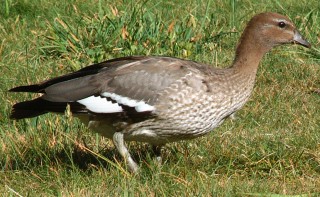 |
The Australian Wood Duck (Chenonetta jubata) is also
known as the Maned Duck, for the small mane on the male (not shown). The
females (left and right) have a light brown head with white stripes
above and below the eye, a speckled breast and underbody and brown- to
black-and-white wings. The male has a darker head with a slight mane,
plain grey sides and black-and-white wings. They are dabbling ducks
(right) as opposed to divers, but are often seen in flocks on the ground
near water, or singly in trees. (Photo left: Kosciusko NP. Photo right:
Canberra) |
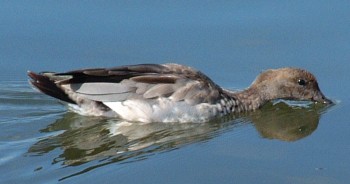 |
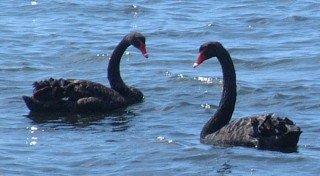 |
Black Swans (Cygnus atratus) can be found near any of
Australia's large
bodies of water ― fresh, estuarine or salt ― and even on pastures and on
mudflats as long as there is enough aquatic life to support them.
They are endemic to Australia and range throughout all of the continent
except the very dry interior. Black swans mate for life, laying eggs in
thick nests in aquatic vegetation. Their trumpeting call is quite
musical and can often be heard flying at night. They fly in long lines,
not the V formation of many geese. They stand almost 1.5 m (58 in)tall, and
have a wingspan of up to 2 m (6.5 ft). Females are slightly smaller than males.
(Lake Myall) |
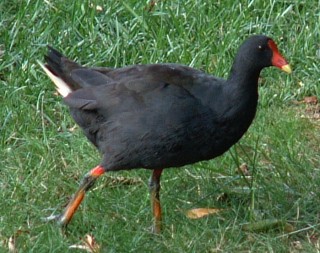 |
On natural and urban lakes throughout most of eastern and SW
Australia the Dusky Moorhen (Gallinula tenebrosa) can be
found either ashore or afloat, feeding on small vertebrates and
invertebrates in the reeds and
grasses. They are primarily diurnal and less secretive than than cousins
the rails. The thick red and yellow-tipped frontal shield is their
distinguishing characteristic, along with a white under-tail coverts and
yellow, orange and greenish legs. Newly hatched moorhens can swim the
day they hatch. (Left: Canberra. Right: Myall Lakes) |
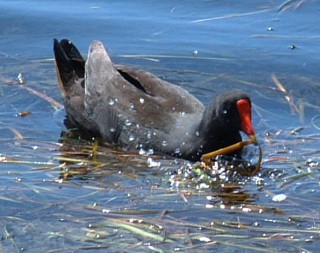 |
| Closely related to the Dusky Moorhen, and also in the Rallidae
family, the Purple Swamphen (Porphyrio porphyrio) can
be found near and in freshwater lakes, and marshes. With its deep blue
chest and all red frontal shield it makes a bright blotch of color in
the grasses and reeds where it resides. Flicking its tail to show the
white undertail coverts is typical, though it is not understood what
purpose it serves. This same bird lives in New Zealand where it it
commonly known as the Pukeko. In Australia is is found in most of the
eastern part of the country and in areas in the far north and SW. (Canberra) |
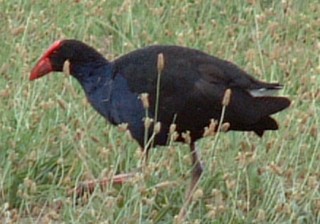 |
Up | Australia Fauna | Australia Mammals | Australia Birds 1 | Australia Birds 2
| Australia Home
| Australia Newsletters
| Australia Cruising Info
West Indies Flora/Fauna | Venezuela Flora/Fauna | SW Caribbean Flora/Fauna | Galapagos Flora/Fauna | Fr. Polynesia Flora/Fauna | Tonga & Fiji Flora/Fauna | Australia Flora/Fauna | Southeast Asia Flora/Fauna | Sri Lanka Flora/Fauna | Madagascar Flora/Fauna | Marine Mammals
Top Level:
Home |
Destinations |
Cruising Info |
Underwater |
Boat Guests |
Ocelot |
Sue |
Jon |
Amanda |
Chris |
Site Map |
Make a Comment
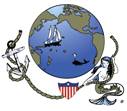 |
Lifetime
Commodores
of the
Seven Seas
Cruising
Association |
 |
|
If our information is useful,
you can help by making a donation
|
Copyright © 2000‑ Contact:
Jon and Sue Hacking -- HackingFamily.com, svOcelot.com.
All rights reserved.
